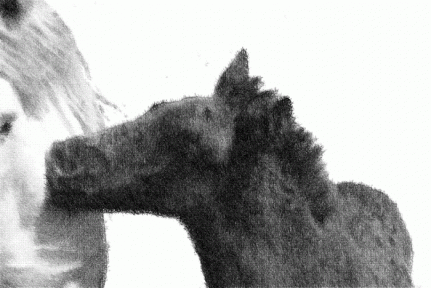A Brief History
Faced with potential extinction in 1970's, (due to tragic external circumstances) the Eriskay Ponies are currently still listed as critically endangered by the RARE BREEDS SURVIVAL TRUST.
Many devoted Islanders and Highlanders have dedicated decades to their breeding and keep and care and with good reason.
A relatively recent 'officially recognised breed' of pony - THE ERISKAY PONY is a distinctive equine that has been DNA'd and proved to be the last living remnant of the ORIGINAL NATIVE SCOTTISH PONY.
Even today, there are many people around the world who have not heard about them - help spread the news.
Special Adaptations
In order for Eriskay Ponies to be able to survive the harsh weather conditions of the Western Hebridean Isles, they are specially adapted and different to other breeds, in many ways.
They have a large nasal area which enables them to warm up the cold air before it enters its lungs. This is true of similar native breeds including the Icelandic and Shetland . Even the old fashioned Welsh Ponies had bigger heads and wider nasal cavities.
Some people think they have big heads and compare them to arabian horses and other pony breeds that have arabian influence. Arabian horses live in a totally different climate and their nasal area is different, they also have the ability to flare their nostrils which is a cooling effect adaptation enabling them to survive their unbearable, hot desert environment.
Eriskay Ponies in contrast have lowset, narrow nostrils which also helps to warm up the air once it is breathed in.
The same goes for the tail area, Eriskay Ponies have lowset tails which tuck in and keep in warmth and Arabian horses prance about with tails high and this helps them cool down. Eriskay Ponies don't prance about and are laid back and relaxed to conserve their energy and body warmth.
Horses in very hot climates have sleek, glossy coats which help them keep cool, whereas Eriskays have thick, waterproof coats to keep them warm. It may be squalling icy sleet outside for hours but they only get wet on the very outside. You never see an Eriskay shivering with cold, whereas horses with thin coats will do this without blankets on. Their hair grows extrememly long and dense, as do their manes, tails and forelocks. Their ears are full of tight dense hair which also protects against rain, sleet and ticks, preventing them from entering.
Even in the worst weather an Eriskay finds shelter in the natural envonment and manages to stay warm and sheltered from the driving rain and winds. On calm, still days they stand tall on the most exposed places basking in the winter sun. Even before we notice they know when a storm is coming and find shelter before it hits.
Another adaption is their colouring and their unique striking black and grey colour allows a whole herd to remain unnoticed amongst their natural rocky landscape.

